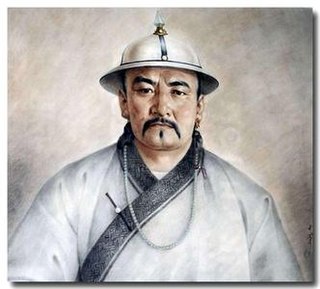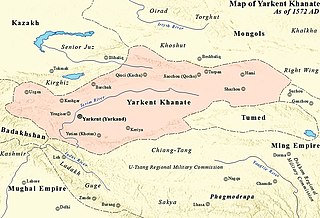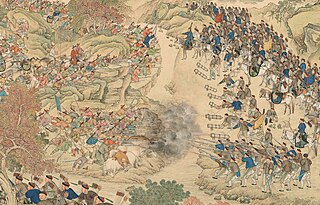
Ahmad Shāh Durrānī (Pashto: احمد شاه دراني; Dari: احمد شاه درانی), also known as Ahmad Shāh Abdālī, was the founder of the Durrani Empire and is regarded as the founder of the modern state of Afghanistan. In July 1747, Ahmad Shah was appointed as King of the Afghans by a loya jirga in Kandahar, where he set up his capital. Primarily with the support of the Pashtun tribes, Ahmad Shah pushed east towards the Mughal and Maratha Empires of India, west towards the disintegrating Afsharid Empire of Iran, and north towards the Khanate of Bukhara of Turkestan. Within a few years, he extended his control from Khorasan in the west to North India in the east, and from the Amu Darya in the north to the Arabian Sea in the south.

The Dzungar Khanate, also written as the Zunghar Khanate, was an Inner Asian khanate of Oirat Mongol origin. At its greatest extent, it covered an area from southern Siberia in the north to present-day Kyrgyzstan in the south, and from the Great Wall of China in the east to present-day Kazakhstan in the west. The core of the Dzungar Khanate is today part of northern Xinjiang, also called Dzungaria.

The Chagatai Khanate, or Chagatai Ulus, was a Mongol and later Turkicized khanate that comprised the lands ruled by Chagatai Khan, second son of Genghis Khan, and his descendants and successors. At its height in the late 13th century the khanate extended from the Amu Darya south of the Aral Sea to the Altai Mountains in the border of modern-day Mongolia and China, roughly corresponding to the area once ruled by the Qara Khitai.

Choros Erdeniin Galdan was a Dzungar-Oirat Khan of the Dzungar Khanate. As fourth son of Erdeni Batur, founder of the Dzungar Khanate, Galdan was a descendant of Esen Taishi, the powerful Oirat Khan of the Northern Yuan dynasty who united the western Mongols in the 15th century. Galdan's mother Yum Aga was a daughter of Güshi Khan, the first Khoshut-Oirat King of Tibet.

Afaq Khoja, born Hidayat Allah, also known as Apaq Xoja or more properly Āfāq Khwāja, was a Naqshbandi īshān and political leader with the title of Khwaja in Kashgaria. He was also known as Khwāja Hidāyat Allāh.

Moghulistan, also called the Moghul Khanate or the Eastern Chagatai Khanate, was a Mongol breakaway khanate of the Chagatai Khanate and a historical geographic area north of the Tengri Tagh mountain range, on the border of Central Asia and East Asia. That area today includes parts of Kazakhstan, Kyrgyzstan, and northwest Xinjiang, China. The khanate nominally ruled over the area from the mid-14th century until the late 17th century, although it is debated whether it was a continuation of the Chagatai Khanate, an independent khanate, or a tributary state to the Ming dynasty.
Sultan Said Khan ruled the Yarkent Khanate from September 1514 to July 1533. He was born in the late 15th century in Moghulistan, and he was a direct descendant of the first Moghul Khan, Tughlugh Timur, who had founded the state of Moghulistan in 1348 and ruled until 1363. The Moghuls were turkicized Mongols who had converted to Islam.
Ismail Khan was Khan of Yarkand and Kashgar between 1666 and 1669. He was replaced by Ilbars Khan from 1669–1670. His khanship was restored from 1670–1680.
Abd ar-Rashid Khan II was Khan of Yarkand and Turpan from 1680–1682. He was son of Baba Khan or Babak Khan. Baba Khan was son of Ismail Khan.

The Dzungar–Qing Wars were a decades-long series of conflicts that pitted the Dzungar Khanate against the Qing dynasty of China and its Mongolian vassals. Fighting took place over a wide swath of Inner Asia, from present-day central and eastern Mongolia to Tibet, Qinghai, and Xinjiang regions of present-day China. Qing victories ultimately led to the incorporation of Outer Mongolia, Tibet and Xinjiang into the Qing Empire that was to last until the fall of the dynasty in 1911–1912, and the genocide of much of the Dzungar population in conquered areas.

The Yarkent Khanate, also known as the Yarkand Khanate and the Kashghar Khanate, was a Sunni Muslim Turkic state ruled by the Mongol descendants of Chagatai Khan. It was founded by Sultan Said Khan in 1514 as a western offshoot of Moghulistan, itself an eastern offshoot of the Chagatai Khanate. It was eventually conquered by the Dzungar Khanate in 1705.

The Revolt of the Altishahr Khojas was an uprising against the Qing dynasty of China, which broke out in 1757 during the reign of the Qianlong Emperor. The rebels were led by Khwāja-i Jahān, leader of the White Mountain Sufis. Qing era documents refer to the event as the "Pacification of the Muslim regions". Hojijan and his brother, Burhān al-Dīn, both held the Muslim title Khoja.

The Dzungar conquest of Altishahr resulted in the Tibetan Buddhist Dzungar Khanate in Dzungaria conquering and subjugating the Genghisid-ruled Chagatai Khanate in Altishahr. It put a final end to the independence of the Chagatai Khanate.

In 1759, the Qing dynasty of China defeated the Dzungar Khanate and completed the conquest of Dzungaria. Concurrent with this conquest, the Qing occupied the Altishahr region of Eastern Turkestan which had been settled by Muslims who followed the political and religious leadership of Afaq Khoja.
Akbash Khan of the Yarkent Khanate was a Central Asian Khan in the beginning of 18th century. He was the last Khan of Yarkent Khanate. He is known as one of the "later Chagatai princes"(察合台後王) in China.










